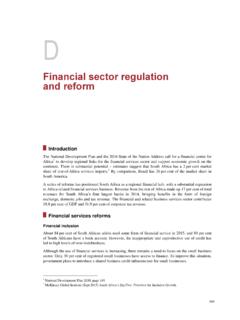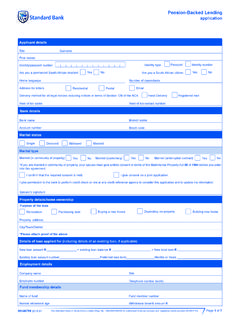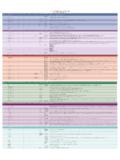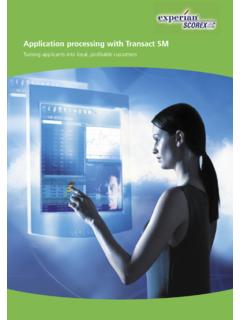Transcription of Reinsurance Trade Barriers and Market Access …
1 22 February 2017 Reinsurance Trade Barriers and Market Access Issues worldwide Global Reinsurance Forum (GRF) 22 February 2017 2 Table of Contents I) Executive Summary II) Current Trade Barriers and Market Access issues: African Union Conf rence Interafricaine des March s d Assurances (CIMA) Argentina Brazil Canada China Ecuador Egypt Ethiopia France Germany India Indonesia Israel Malaysia Namibia Nigeria Pakistan Philippines Poland Portugal Russia Singapore South Africa South Korea Sri Lanka Thailand UK USA III) Potential future Trade Barriers and Market Access issues.
2 Canada China Indonesia Nepal Russia South Africa Vietnam 3 Executive Summary Global Reinsurance Forum (GRF) members account for more than 65% of global net Reinsurance premiums. The GRF believes that positive and significant economic benefits will result from the free global flow of risk through open and competitive Reinsurance markets. The GRF has identified 30 major territories including regional groupings around the world which have either implemented, or are in the process of implementing, Barriers to the transfer of risks through global Reinsurance markets.
3 This is an increase of 2 new territories from the last edition of this document (August 2016) and 4 new territories since January 2016. This rise marks an increasing worldwide trend, which undermines the efficiency of Reinsurance markets. Such Barriers reduce competition leading to reduced customer choice, higher Reinsurance costs and less capacity over the long-term horizon. These Reinsurance Trade Barriers and Market Access issues include but are not limited to: Restrictions on the ability of reinsurers to freely conduct business on a cross-border basis, thus limiting the capacity of global reinsurers to spread risk globally and to prevent domestic concentrations of risk.
4 Varying levels of restriction are witnessed or developing in Argentina, China, Ecuador, Egypt, Ethiopia, Germany, India, Indonesia, Malaysia, Nepal, Nigeria, the Philippines, Poland, Russia, South Africa, South Korea, Sri Lanka, Vietnam, as well as the groupings of other member countries of the African Union and the grouping of the Conf rence Interafricaine des March s d Assurances. Requirements for reinsurers operating on a cross-border basis to collateralise or localise assets, preventing the global Reinsurance Market from transferring and spreading risk on the basis of a competitive, level playing field across borders.
5 Such requirements exist or are evolving in jurisdictions including Brazil, Canada, China, Ecuador, Israel, Portugal, Singapore, South Africa and the United States. Barriers to the establishment of branches, subsidiaries and operations restricting the ability of reinsurers to deliver their full economic benefit by providing local underwriting expertise and direct services to transfer risk out of domestic markets on an open and competitive basis. Such Barriers are present or developing to varying extents in a number of jurisdictions including, but not limited to: Brazil, China, Egypt, India, Indonesia, Malaysia, Nigeria, Russia, South Africa, Thailand and the UK.
6 The use of discriminatory and anti-competitive mechanisms such as compulsory cessions to domestic entities, systems of 'right of first refusal', and compulsory, subsidized or monopolistic governmental mechanisms limiting the competitive capacity of global reinsurers to operate on a level playing field. Such practices concentrate risk domestically, whilst limiting customer choice, and can be witnessed to varying degrees in the African Union, Argentina, Brazil, China, Egypt, France, India, Indonesia, Malaysia, Namibia, Nepal, Nigeria, the Philippines, Sri Lanka, Thailand, the United States, Vietnam and elsewhere.
7 4 Developments since the last edition of this document was published in August 2016: On 1 August 2016, the Ethiopian regulator published Directive No SIB/44/2016 that imposes mandatory cession requirements for each Reinsurance policy in Ethiopia. A minimum 25% of all treaty cessions and 5% of each Reinsurance policy must be ceded to a local reinsurer. Reinsurance policies that were concluded prior to 1 August 2016 will be subject to the new requirements at renewal. On 1 January 2017, the Namibia National Reinsurance Corporation Act 1998 will be enforced, establishing mandatory cession of each insurance policy and 20% of each Reinsurance policy issued in or outside of Namibia for Namibian risks to be ceded to NamibRe.
8 NamibRe will have the right of first refusal to take on Reinsurance business over and above the compulsory cession. On 16 January 2017, the Indian regulator, IRDAI, enforced its Regulation 28(9) which puts into place an Order of Preference for Reinsurance business in India. The regulation comes into effect immediately. It creates a four tiered system that effectively creates a first right of refusal in favour of domestic reinsurers for Reinsurance business before it goes to branches of foreign reinsurers and cross-border reinsurers.
9 During their Management Board Meeting on 15 October 2016, the 10 member countries of Asian Re (Afghanistan, Bangladesh, Bhutan, China, India, Iran, Philippines, South Korea, Sri Lanka, and Thailand) published and discussed a report which explored options to introduce compulsory cession requirements from the 10 member countries to Asian Re. This seems to be a response to a significant decrease in the flow of business to Asian Re as a result of the downgrading of its credit rating.
10 At present, the 10 member countries have a flexible and loosely enforced agreement to provide cessions to Asian Re of 5% of all outward Reinsurance business or $ , whichever is the lesser amount. A decision on compulsory cessions will be made by the Council of Asian Re in June 2017. After consideration, the Korean insurance regulator (FSS) decided in December 2016 not to introduce restrictions on the placement of Korean risks on a cross-border basis in 2017. FSS considered introducing a right of first refusal with preference for local placement or introducing local collateral requirements for licenced cross-border reinsurers.








